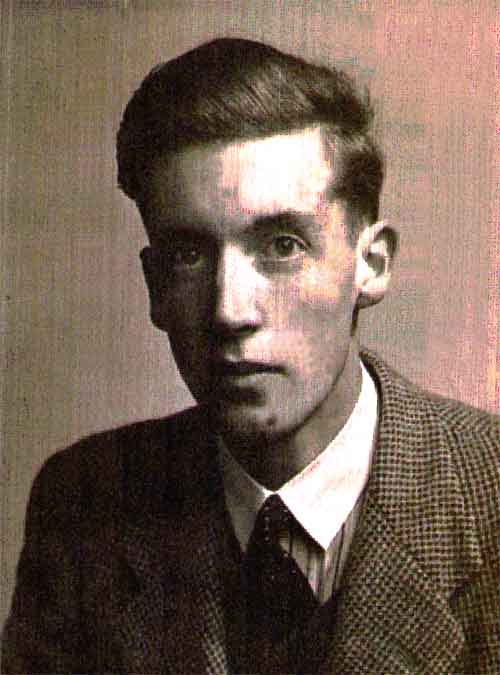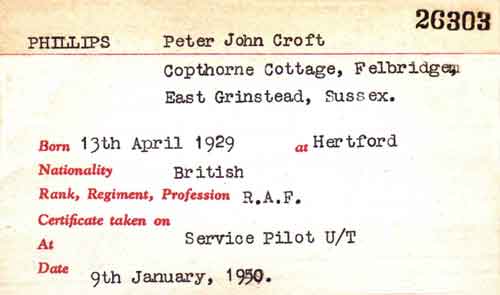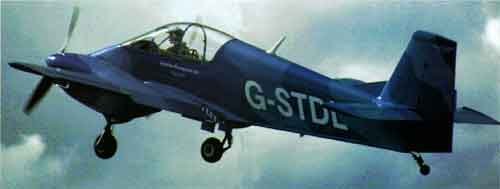| Flight Lieutenant Peter John Croft Phillips - 4 Sqn pilot Nov52 to 1955. | ||
|
He returned to this country in 1955 and carried out a further "Instruction Tour" on Vampires, and joined the Station Acrobatic Team Flying Vampires. From 1956-58 he was on the flying staff at C.F.S. and from 1957-58 he was the C.F.S. Aerobatics representative on Vampires and took part in many R.A.F. Air Displays. After leaving C.F.S. he joined No. 92 Squadron, and afterwards No. 54 Squadron, both being high level and ground attack squadrons, equipped with Hunters, and carried out aerobatics with this Squadron from the summer of 1959-60. During the time he was with No. 54 Squadron, he was introduced to The Tiger Club, and went with the British Team to Czechoslovakia to compete in the World Acrobatic Championships, in whnch he flew a "hotted-up" Tiger Moth, known as the "Bishop Version" which proved to be no match for the Continental aircraft, but whilst there he had the opportunity of flying a "Zlin' and no doubt convinced the Continentals that it was the machine that made the difference? In fact the "Zlim" was considered one of the best acrobatic light aircraft in the World. During the same year he entered the "Lockheed Trophy Competition" again flying a Tiger Moth, and was again outclassed by the Continental machines. The Tiger Club then purchased a "Stampe", which has been fitted with an inverted flying fuel system, and after only a few hours' experience with the "Stamps" he flew this aircraft in the 1962 Lockheed Trophy Competition and was placed third, the very first time that one of our own pilots had been "placed'': a very creditable performance in view of the high Continental competition. Since leaving the R.A.F. he has given dozens of acrobatic and team displays with the Tiger Club. Sadly Peter died 11Nov94 aged 66. ARTICLE FROM PILOT
At this July's Farnborough show Speedtwin Developments displayed the second prototype, first flown in 1997. Development of this aircraft, now named Speedtwin Comet 1, was curtailed by Phillips' death. The company is seeking investment to launch series production, and is promoting the aircraft not only for sport flying and multi-engine training, but also as a platform for border/coastal patrol, airborne surveillance and, equipped with a 20mm cannon, for armed response and battlefield support. The aircraft has had its original Walter M332B engines replaced by Lycomings, and Speedtwin's Malcolm Ducker moots a turboprop version with Rolls-Royce M250s as a possible future development. The Comet 1 has an all-metal airframe stressed to +6/-3g, boasts a 2,000fpm rate of climb, 264mph maximum speed and a maximum range of 900nm. For surveillance roles Ducker says the aircraft could remain on station, with one engine shut down, for up to seven hours, and is a credible alternative to UAVs. speedtwin.co.uk AN ENTHUSIATIC WRITE-UP AFTER A TEST FLIGHT "ETOPS AIRTOURER" Around the year 1993 I had gone to Europe in connection with my business as Service agent for Suizer Diesel in Australia. Whilst there, I took the opportunity to visit with remaining family in London. I noticed an intriguing article in English "PILOT" magazine, which described the air test of a prototype aerobatic light twin, called the "SPEEDTWIN", designed and built by one Peter Phillips. The attached photos showed a taildragger, tandem seat aircraft, with Airtourer dimensions and with wings and tailfeathers bearing a distinct resemblance to our own! Peter Phillips turned out to be a retired RAF pilot who had flown Meteors, Vampires and Sabres in the post war era. Peter's first love was aerobatics, and on leaving the service he flew air show display in Tigers, Stampes, and a Bob Hoover type routine in Britten-Norman Islanders. He was demonstration pilot for the Beagle aircraft, and was at one stage Sales Manager for the VICTA aircraft distributor in U.K.(Glos Air I think). Back to the story, I found Peter's home number and rang him at his farm in Trellech, a small village in Wales. After discussion I was invited to come and fly the machine, and duly set off with the family. "Cae Gaw" farm turned out to be some fifty acres of rolling Welsh hills in Monmouth, with it's own airstrip of about 450 m in length roiling up one of the hills, covered in long, wet grass and daisies, and with a large oak tree marking each side of the uphill threshold! On arrival we were welcomed with open arms, and while Peter's wife entertained my family, we went off to prepare the aircraft for a sortie. "G-PST" did indeed have some Airtourer components and was of similar dimensions. She had two "Continental" 0-200's, fixed pitch wooden props, and was finished in the most beautiful blue metallic paint with gold cheat lines. The finish and workmanship were outstanding and I couldn't wait to sample! The cockpit was of narrow but comfortable dimensions, and the view was like sitting in a Vampire. The instructors seat was raised to give him a view over the blockhead in the front cockpit! I was sent off with Peter's chief pilot, and the stiff breeze indicated an uphill take off. I expressed some concern, but was told "Don't worry, it will fly itself of the top of the hill, just make sure you go between the trees!" I wound up the trusty 0-200's, released the brakes, and to my great surprise lifted off after a short run to gaze down on the top of the oak trees a couple of hundred feet below! My logbook shows a landing at a grass strip called Oaksleigh, across the river Severn estuary back in England, followed by a cup of tea at the local flying club, and a return to the farm at Trellech. It does nothing to describe the superb performance and incredible handling of the "Speedtwin"! We climbed out at an indicated 1200 ft/min to 5000 MSL in around four minutes, whereupon I was urged to "chuck it around a hit". Stalls were straight ahead, clean or dirty, at around 55 KIAS, with recovery in 100 ft or less. With left engine at ground idle, only an asymmetric application of big toe and two fingers was needed, followed by a 250 ft/min climb at the blueline speed of 78 KIAS. This at our all up weight of around 1850 lbs. including 80 litres of fuel, despite the drag of the fixed pitch prop. Try that in an "Apache"! We quickly trued out at 140 KIAS on 70% power, and after throttling back to 2200 RPM were still showing 110 KIAS at 3000 ft, and consuming about 20 Lt/hr both engines at this reduced and very quiet cruise. With a three-G pull from an entry speed of 145 KIAS we did a near perfect loop (for me!) with feet off the rudders, showing 65 knots over the top. The design incorporates something Peter calls RAP i.e. "Remote Aerodynamic Power", which was his improvement on aerobatic spades, consisting of a pair of small variable vanes mounted forward facing under the belly. The torque generated by these vanes is applied through linkage to the ailerons, and the force applied can be varied to suit the individual pilot through adjustable length bell cranks. The result is aileron feel that remains the same regardless of aircraft attitude, coupled with stability that holds the aircraft at any angle "hands off". All this, together with the view over the steeply sloped nose, and a sunny day (at altitude!) had me tempted to abscond with the aircraft! A landing with no perceptible taildragger vices brought us back to the hangar/barn/factory, where Peter employed five people building the production version, which he intended to sell in modular kit form in the near future. I submitted an immediate request for my name to go on the list for the early deliveries, however Peter Phillips was in a wheelchair on the day of our visit, and he sadly passed away from cancer in the following year. (Peter died 11Nov94 aged 66). I was totally amazed when after letting a total stranger from Australia fly his aeroplane, Peter and his wife insisted on giving us lunch, and positively refused to let me pay for the aircraft's fuel. The man and his machine are a great loss to aviation. I recently wrote to the editor of "Pilot" magazine to try and find out what became of the project, but could discover only that it was thought to have been sold to American interests. Peter told me that he had also designed a Mk II version with two "Lycoming" 10-320's and constant speed props, for later development. What a great project to keep young and poor in old age!! Any takers to join me? NOT SO LUCKY! From Flying Show Accident Reports: 9th October 1977 - Lanseria Airport, near Johannesburg, South Africa - Demonstration Pilot Peter Philips flying a Britten-Norman Trislander in flying display performed a second wing-over and had insufficient altitude to recover. Impacted the runway and bounced into the air and came to rest some 500m further off to the side of the runway. The flying controls were disabled and main gear detached. One wing engine detached. Philips was accompanied by Mike Wrigly - both survived with minor injuries although had to spend a few days in hospital. Aircraft written off. |


